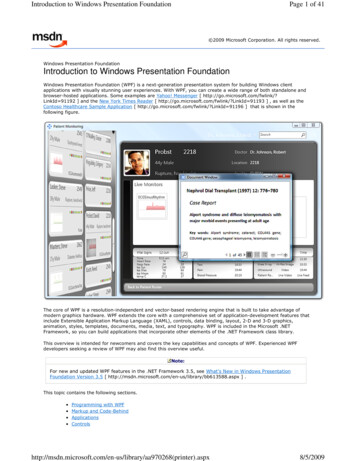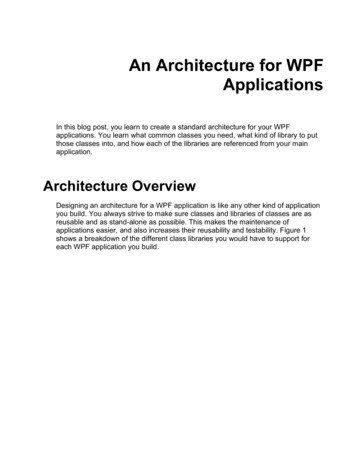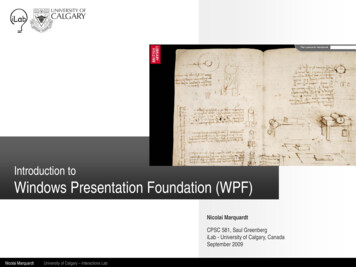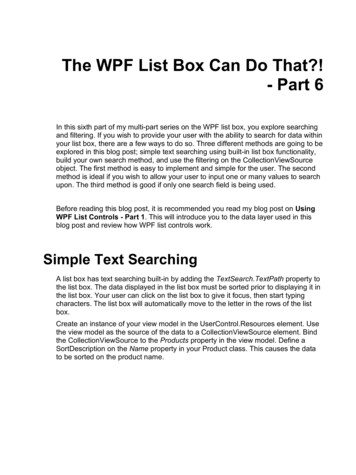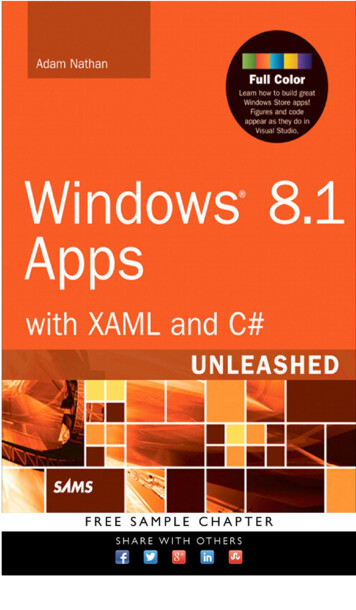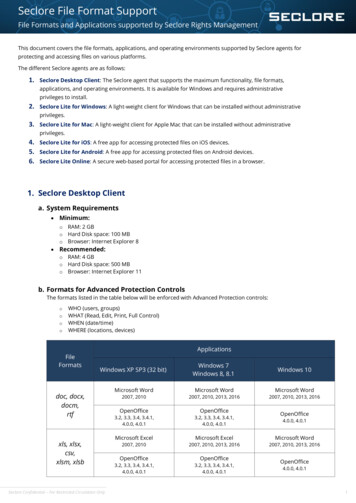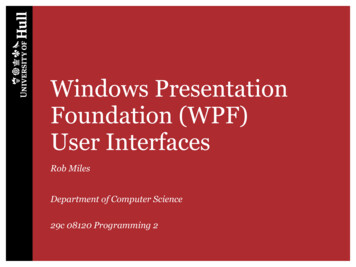
Transcription
Windows PresentationFoundation (WPF)User InterfacesRob MilesDepartment of Computer Science29c 08120 Programming 2
Design Style and programming As programmers we probably start of just worrying aboutmaking the program work– This is a very good place to start But in modern systems the “look and feel” of the userinterface is very important– No matter how good the code is, if the program is hardto use it will not be popular You should pay careful attention to user interface issueswhen making your programs2Windows Presentation Foundation
Separating User Interface Design and Code It turns out that programmers are not always very good atgraphic design– And that graphic designers are not very good atprogramming To make a good application we need a good user interfacedesign and code that works It makes sense to separate programming and design andmake it easy for the graphic designer and the programmer towork together3Windows Presentation Foundation
Windows Presentation Foundation (WPF) The Windows Presentation Foundation separates the userinterface design from the program code by the use of a“markup” language called XAML– This stands for “eXtensible Application MarkupLanguage”– It describes the arrangement of items on a window The designer can create the XAML and the programmer canuse the objects defined in it to create the code Visual Studio provides an environment where the XAML andthe program can be worked on together4Windows Presentation Foundation
XAML and Windows Presentation Foundation A WPF application is made up of pages that containelements These have properties that determine where they are, howthey appear and what they can do in an application The Visual Studio tool allows us to manipulate the pagecontent by using the design surface and the elementproperties pane5Windows Presentation Foundation
Expressing WPF Elements The description of the elements in a WPF application isactually held in a text file This file is formatted in a particular way Microsoft invented a language, XAML to hold this designinformation:– eXtensible Application Markup Language XAML was invented to hold user interface designinformation It is based on the XML standard6Windows Presentation Foundation
Why do we need XAML? XAML allows us to separate the role ofgraphic designer and programmer– The designer should not have to seecode objects to work– The programmer should not be heldback while the design is produced The XMAL file provides a separationbetween the code that drives theapplication and the way the applicationlooks7Windows Presentation Foundation
XAML file content TextBox Height "23" HorizontalAlignment "Left"Margin "12,12,0,0" Name "firstNumbertextBox"VerticalAlignment "Top" Width "120" / This snippet of XAML is the description of a textbox on thescreen firstNumberTextBox in the AddingMachineapplication It contains fields that describe the position and size of thetextbox This file is managed by Visual Studio as your program isbeing developed8Windows Presentation Foundation
XAML in Visual Studio The XAML file holds the information which is updated byboth views9Windows Presentation Foundation
The XAML language XAML is a “declarative” language It just tells us about things, it does not tell us what they doand how they can do it The XAML file has a particular format– The characters and are used to mark the start andend of some elements in the file The format looks a bit like XML– eXtensible Markup Language10Windows Presentation Foundation
Using XAML You can actually edit the XAML text in your project tocreate new display elements and modify existing ones This can often be much quicker than using the editinginterface provided by Visual Studio You just have to type the new values into the XAMLwindow and the properties of the element are changedimmediately11Windows Presentation Foundation
The XAML file at run time When a WPF program runs the XAML file is compiled intoa set of low level display instructions that are obeyed by theruntime system This is the point at which the XAML object descriptions inthe text are converted into program objects we can use inour code This all happens automatically as far as we are concerned The program can just use the display elements as objects inthe code, rather like we use the Console object12Windows Presentation Foundation
XAML and XML XAML looks a bit like XML– XML means “Extensible Markup Language” This means that XML is really a way of designing languagesthat want to talk about something Just like the english language lets us invent verbs andnouns and put them into sentences that have meaning in aparticular context13Windows Presentation Foundation
Quick intro to XML ?xml version "1.0" encoding "us-ascii" ? HighScoreRecords count "2" HighScore game "Breakout" playername Rob Miles /playername score 1500 /score /HighScore HighScore game "Space Invaders" playername Rob Miles /playername score 4500 /score /HighScore /HighScoreRecords I invented this XML format to hold a video game high scoretable14Windows Presentation Foundation
HighScore element HighScore game "Breakout" playername Rob Miles /playername score 1500 /score /HighScore The HighScore element contains two other elements,playername and score It also has a property that gives the name of the game I could add others, for example the date and time the scorewas achieved It is easy for us to work out what the elements are there for15Windows Presentation Foundation
HighScoreRecords element ?xml version "1.0" encoding "us-ascii" ? HighScoreRecords count "2" HighScore game "Breakout" playername Rob Miles /playername score 1500 /score /HighScore HighScore game "Space Invaders" playername Rob Miles /playername score 4500 /score /HighScore /HighScoreRecords The HighScoreRecords element contains a count of thenumber of HighScore elements16Windows Presentation Foundation
XML and data structures We can invent our own language format whenever we havesome structured data that we want to store The designers of XAML have done this Rather than store high scores they have created a languagethat lets us design user interfaces17Windows Presentation Foundation
The XAML data revisited TextBox Height "23" HorizontalAlignment "Left"Margin "12,12,0,0" Name "firstNumbertextBox"VerticalAlignment "Top" Width "120" / We can see that the XAML content that describes a textboxis very similar to a HighScore element The designers of XAML had to work out what data fieldsare required in a TextBox object Each display element has a set of fields Visual Studio provides intellisense to help you create these18Windows Presentation Foundation
What is a Markup Language? The “ML” in XML stands for “Markup Language” A markup language was originally a set of commands forthe printers of a document– ‘Put the words “Table of Contents” in bold’ When the World Wide Web was created the Hyper TextMarkup Language was designed to allow a text file todescribe a particular web page design However, there are lots of other markup languagesavailable19Windows Presentation Foundation
XML and HTML The idea of creating your own markup language was such agood one that people wanted a standard form for doingthis XML came out of this drive for standards– It is the way in which the files use the and / andother characters to mean the start and end of elements,names and properties– It also tells you how to create “schemas” that define thestructure and content of XML documents20Windows Presentation Foundation
XML Schema An XML schema describes a particular XML documentformat:– “A HighScore element must contain a PlayerName and aScore value, but the Date value is optional” Programs can use a schema to make sure that a particulardocument contains content which is valid The schema in use is identified in the header of an XMLdocument Microsoft have created a schema for the XAML language21Windows Presentation Foundation
XML and software XML allows programs to share data irrespective of whatkind of system was used to create the data There are many software tools that can create schemas andyou can even store the contents of C# directly into XMLstructured files However, for now just remember that the description of aWPF page is a text file containing an XAML documentwhich is formatted according to XML using a schema thatdetermines how all the elements are to be used22Windows Presentation Foundation
XAML and WPF Pages A WPF application is made up of a number of pages Each page is expressed using a single XAML source file The page will contain descriptions of a number of WPFelements– Some elements can contain other elements Visual Studio manages the XAML source file as we work onthe application Items described in the XAML appear as objects in theprograms that we create23Windows Presentation Foundation
WPF Components There are lots of different components available to be addedto a window– Label: a text label– TextBox: a box the user can type into– Button: a button that the user can press A program can interact with a component by using thebehaviours that it provides– We can change the text in a Label to display a message– We can read the text from a TextBox to get user input– A Button can generate events when it is clicked24Windows Presentation Foundation
Sample Application The Calc program just adds twonumbers together The user enters the numbers andpresses the button to start a calculation The result is displayed using a label25Windows Presentation Foundation
Designer View This is the designer view of theapplication I added each item in turn to the screen– Visual Studio provides some very goodtools to help line the items up I can also change the size of theapplication window by dragging thehandles attached to the window26Windows Presentation Foundation
XAML View GridHeight "192" Width "170" TextBox Height "23" HorizontalAlignment "Left“Margin "12,12,0,0" Name "firstNumbertextBox"VerticalAlignment "Top" Width "120" / Label Content " " Height "28" HorizontalAlignment "Left"Margin "56,41,0,0" Name "plusLabel" VerticalAlignment "Top" / TextBox Height "23" HorizontalAlignment "Left"Margin "12,65,0,0" Name "secondNumberTextBox"VerticalAlignment "Top" Width "120" / Label Content " " Height "28" HorizontalAlignment "Left"Margin "56,94,0,0" Name "resultLabel" VerticalAlignment "Top" / Button Content "Calculate" Height "23" HorizontalAlignment "Left"Margin "12,128,0,0" Name "CalculateButton" VerticalAlignment "Top"Width "120" / /Grid This is the XAML that describes the items in the window27Windows Presentation Foundation
Buttons and Events The CalculateButtoncomponent will appear on theform and the user can click it However, at the moment thebutton doesn’t do anything What we need to do next is bindan event to button In other words, we want someC# to run when the buttonclicked28Windows Presentation Foundation
XAML designs and C# Code Each XAML page has a C# programpage which is shown in SolutionExplorer as being “behind” the window Each Window in an application isimplemented by a class This is where a programmer can putcode that makes the user interface work This includes the handler for the buttonclicked event29Windows Presentation Foundation
An Empty Window Classpublic partial class MainWindow : Window{public MainWindow(){InitializeComponent();}} An empty window just contains a call to theInitializeComponent method This call is made when the constructor for the window iscalled The method creates all the components that appear on thescreen30Windows Presentation Foundation
Window Class Methodspublic partial class MainWindow : Window{public MainWindow(){InitializeComponent();}} When we add code that responds to events from the user wewill put this code into the MainWindow class The methods that respond to button press events run in here The methods that display values to the user will run in here31Windows Presentation Foundation
Responding to Events When CalculateButton is clicked it needs a way of “telling”a program that this event has occurred In C# an event is delivered by a call of a method– Our program will contain a calculateButton Clickmethod that is called when the finish button is clicked– This will read the new text back from the TextField andupdate the name of our customer We need a way of connecting the CalculateButtoncomponent to the method we want it to call when it is clicked32Windows Presentation Foundation
Referring to Methods using Delegates We are familiar with the use of references to refer to objects– A reference is a tag that can be tied to a particular objectin memory Delegates are an extension of references which refer tomethods rather than objects– The value of a delegate can be set to refer to a method in aclass We can connect buttons to methods by doing this:– Create a delegate that refers to the method we want to use– Give this delegate to calculateButton so that it knowswho to call when the button is clicked33Windows Presentation Foundation
Connecting to the Component Button Content "Calculate" Height "23"HorizontalAlignment "Left" Margin "12,128,0,0"Name "CalculateButton" VerticalAlignment "Top"Width "120" Click "CalculateButton Click" / The XAML that describes the button can contain a Clickvalue that identifies the method to be called when the buttonis clicked Visual Studio will do the “plumbing” behind the scenes tocreate the method and the delegate and connect it all to thebutton We will discover how this works later in the course34Windows Presentation Foundation
Creating the Event Handler The simplest way to create an event handler for button is todouble click on the button in the Visual Studio graphical userinterface This will update the XAML as shown above and create anevent handler in the window class that we can add code to You can also manage the events that a component producesby managing its properties Each component can generate a particular set of events35Windows Presentation Foundation
The Event Handler in a Window Classpublic partial class MainWindow : Window{private void CalculateButton Click(object sender,RoutedEventArgs e){}} This is the empty event handler Our program can ignore the parameters (although these canbe used so it can determine which object generated theevent) The method is called each time the button is clicked by theuser36Windows Presentation Foundation
Performing the Calculationprivate void CalculateButton Click(object sender,RoutedEventArgs e){int v1 int.Parse(firstNumbertextBox.Text);int v2 int.Parse(secondNumberTextBox.Text);int result v1 v2;resultLabel.Content " " result;} Visual Studio makes an empty method for the event handler We can fill in the code to make it perform the required task In this case it calculates the result and displays it37Windows Presentation Foundation
Running the Program The interesting thing about this programis that once it has loaded the window ontothe screen it then does nothing– There is a Main method in theapplication, but this just starts offcreating the window Once the program is active it is simplywaiting for the user to press the calculatebutton38Windows Presentation Foundation
IMPORTANT MESSAGE A Window is just the thing that displays the user interfacefor your program– It provides a link between the user and the data objectsthat they are working withYou should not try to store anyof your business data insidethe Window class39Windows Presentation Foundation
Sensible Way To Workpublic partial class MainWindow : Window{Bank activeBank;public MainWindow(){InitializeComponent();}} The variable activeBank contains a reference to the bankthat the user is working with The bank will contain methods that will let code in the userinterface find accounts and get data from them for display40Windows Presentation Foundation
Stupid Way To Workpublic partial class Account : Window{string customerName;public Account(){InitializeComponent();}} The program is trying to store business data (the name of acustomer) inside the Window class that is driving the userinterface This is not the right thing to do, we don’t want to have tostore buttons and labels when we store a customer41Windows Presentation Foundation
Very Sensible Way To Workpublic partial class CustomerEditWindow : Window{string selectdCustomerName;public MainWindow(){InitializeComponent();}} This is much more sensible The string is set to the name of the customer account that iscurrently being edited Methods in the window could update this name and save itback in the account42Windows Presentation Foundation
Windows Presentation Foundation Summary Windows are displays on the screen that aremanipulated as C# objects The design of the objects on the screen is expressedusing the XAML language Windows can contain components such as Label,TextBox and Button The Button component can generate an event when it isclicked You can use delegates to tell the button which methodto call when a click event occurs43Windows Presentation Foundation
Windows Presentation Foundation (WPF) The Windows Presentation Foundation separates the user interface design from the program code by the use of a "markup" language called XAML -This stands for "eXtensible Application Markup Language" -It describes the arrangement of items on a window
